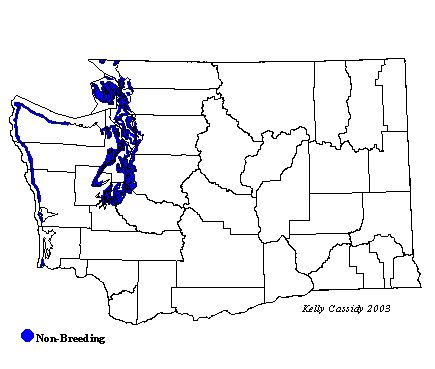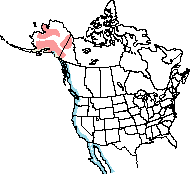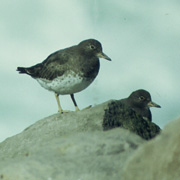Surfbird
General Description
The Surfbird is a plump shorebird with a short, plover-like bill, gray above and orange below. Its gray wings show prominent, white wing-stripes in flight. The tail has a white base with a black subterminal band. In breeding plumage, the Surfbird has salmon-colored patches on its wings. These fade considerably during the breeding season, and may be peach or almost white by the time the birds return to Washington in the fall. Birds in breeding plumage are covered with a wash of dark spots, giving them an overall speckled appearance. The juvenile is gray with white-edged feathers and a breast flecked with white. The adult in non-breeding plumage is also gray, but lacks the white-edged feathers and has no streaks on its breast.
Habitat
Surfbirds spend their entire lives in rocky areas. They breed in the rocky mountain tundra of Alaska and the Yukon, and migrate to rocky coastal shores. In winter, they are almost always within a few meters of the tidal line. They sometimes forage in non-rocky areas, but this is unusual.
Behavior
Surfbirds occur in small flocks, usually with fewer than 25 birds, and are almost always seen in Washington with Black Turnstones. They are also seen with Rock Sandpipers, Wandering Tattlers, and occasionally Ruddy Turnstones. The Surfbird's bill is well adapted to prying food off rocks.
Diet
The summer diet consists of insects, spiders, and other invertebrates. Surfbirds also eat seeds. In coastal areas, they eat mussels, barnacles, and limpets. The Surfbird eats these creatures shells and all, unlike the Black Turnstone which pulls the creature from its shell.
Nesting
There are many unknowns in the nesting biology of the Surfbird. Its nesting habitat is on remote, rocky ridges above the timberline. In areas with grazing sheep and caribou, Surfbirds remain on the nest until the last moment, and then fly up in the intruding animal's face, a defense mechanism used on humans as well. Pairs form on the breeding grounds. The nest is located on the ground in a natural depression, usually completely exposed. Both parents help line the nest with lichen, leaves, and moss. Males are known to incubate, but female incubation has not been confirmed. Incubation lasts for 22-24 days. The young leave the nest within a day or so of hatching and feed themselves. It is not clear whether both adults, or only the male, tend the young. Fledging age is not known.
Migration Status
The winter range of the Surfbird is one of the longest and narrowest of any North American breeding bird, stretching from southern Alaska to southern Chile. In spring, most of the population gathers in Prince William Sound before heading to breeding sites.
Conservation Status
The Canadian Wildlife Service estimates the Surfbird population at 70,000 birds. They are listed as a species of special concern on the Partners in Flight watch list due to their limited breeding distribution, their vulnerability to oil pollution, and expanding development in their coastal wintering range.
When and Where to Find in Washington
Surfbirds may be present on Washington's outer coast in all months, although they are least common in June. The earliest returning migrants may arrive at the end of June, but most start to arrive in July. They are common from July to April, when they start migrating north for the breeding season. By the end of May into early June, they are rare in Washington. The northward migration peaks from mid-April to early May, and the fall migration peaks in August. Juveniles usually arrive about a month later than adults. They are uncommon in the protected waters of Puget Sound, but can often be seen at Penn Cove on Whidbey Island (Island County) and Duwamish Head in West Seattle (King County). There are typically many Surfbirds on the jetty at Ocean Shores (Grays Harbor County), which is one of the few places where Surfbirds are generally more common than Black Turnstones.
 Abundance
Abundance
| Ecoregion | Jan | Feb | Mar | Apr | May | Jun | Jul | Aug | Sep | Oct | Nov | Dec |
|---|---|---|---|---|---|---|---|---|---|---|---|---|
| Oceanic | ||||||||||||
| Pacific Northwest Coast | C | C | C | C | R | U | C | C | C | C | C | |
| Puget Trough | F | F | F | F | R | R | U | U | F | F | F | |
| North Cascades | ||||||||||||
| West Cascades | ||||||||||||
| East Cascades | ||||||||||||
| Okanogan | ||||||||||||
| Canadian Rockies | ||||||||||||
| Blue Mountains | ||||||||||||
| Columbia Plateau |
Washington Range Map

North American Range Map


Family Members
 Spotted SandpiperActitis macularius
Spotted SandpiperActitis macularius Solitary SandpiperTringa solitaria
Solitary SandpiperTringa solitaria Gray-tailed TattlerTringa brevipes
Gray-tailed TattlerTringa brevipes Wandering TattlerTringa incana
Wandering TattlerTringa incana Greater YellowlegsTringa melanoleuca
Greater YellowlegsTringa melanoleuca WilletTringa semipalmata
WilletTringa semipalmata Lesser YellowlegsTringa flavipes
Lesser YellowlegsTringa flavipes Upland SandpiperBartramia longicauda
Upland SandpiperBartramia longicauda Little CurlewNumenius minutus
Little CurlewNumenius minutus WhimbrelNumenius phaeopus
WhimbrelNumenius phaeopus Bristle-thighed CurlewNumenius tahitiensis
Bristle-thighed CurlewNumenius tahitiensis Long-billed CurlewNumenius americanus
Long-billed CurlewNumenius americanus Hudsonian GodwitLimosa haemastica
Hudsonian GodwitLimosa haemastica Bar-tailed GodwitLimosa lapponica
Bar-tailed GodwitLimosa lapponica Marbled GodwitLimosa fedoa
Marbled GodwitLimosa fedoa Ruddy TurnstoneArenaria interpres
Ruddy TurnstoneArenaria interpres Black TurnstoneArenaria melanocephala
Black TurnstoneArenaria melanocephala SurfbirdAphriza virgata
SurfbirdAphriza virgata Great KnotCalidris tenuirostris
Great KnotCalidris tenuirostris Red KnotCalidris canutus
Red KnotCalidris canutus SanderlingCalidris alba
SanderlingCalidris alba Semipalmated SandpiperCalidris pusilla
Semipalmated SandpiperCalidris pusilla Western SandpiperCalidris mauri
Western SandpiperCalidris mauri Red-necked StintCalidris ruficollis
Red-necked StintCalidris ruficollis Little StintCalidris minuta
Little StintCalidris minuta Temminck's StintCalidris temminckii
Temminck's StintCalidris temminckii Least SandpiperCalidris minutilla
Least SandpiperCalidris minutilla White-rumped SandpiperCalidris fuscicollis
White-rumped SandpiperCalidris fuscicollis Baird's SandpiperCalidris bairdii
Baird's SandpiperCalidris bairdii Pectoral SandpiperCalidris melanotos
Pectoral SandpiperCalidris melanotos Sharp-tailed SandpiperCalidris acuminata
Sharp-tailed SandpiperCalidris acuminata Rock SandpiperCalidris ptilocnemis
Rock SandpiperCalidris ptilocnemis DunlinCalidris alpina
DunlinCalidris alpina Curlew SandpiperCalidris ferruginea
Curlew SandpiperCalidris ferruginea Stilt SandpiperCalidris himantopus
Stilt SandpiperCalidris himantopus Buff-breasted SandpiperTryngites subruficollis
Buff-breasted SandpiperTryngites subruficollis RuffPhilomachus pugnax
RuffPhilomachus pugnax Short-billed DowitcherLimnodromus griseus
Short-billed DowitcherLimnodromus griseus Long-billed DowitcherLimnodromus scolopaceus
Long-billed DowitcherLimnodromus scolopaceus Jack SnipeLymnocryptes minimus
Jack SnipeLymnocryptes minimus Wilson's SnipeGallinago delicata
Wilson's SnipeGallinago delicata Wilson's PhalaropePhalaropus tricolor
Wilson's PhalaropePhalaropus tricolor Red-necked PhalaropePhalaropus lobatus
Red-necked PhalaropePhalaropus lobatus Red PhalaropePhalaropus fulicarius
Red PhalaropePhalaropus fulicarius

